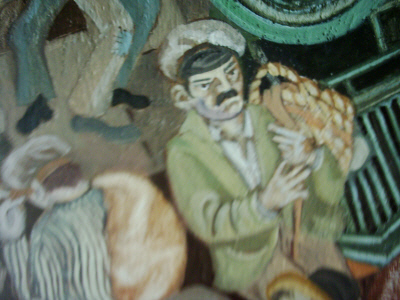
There have been several waves of Italian visitation and emigration to the American continent, the first during the great age of exploration and discovery.
Cristoforo Colombo discovered latin America arriving in the Bahamas in 1492, thinking that it was Asia and claiming it for the Spanish Crown.
Amerigo Vespucci - for whom America is named, made two journeys, 1499 and 1501 and discovered that the continent had two parts, North and South and neither was Asia.
Giovanni Caboto in the service of the English merchants landed on 'a new founde lande' giving the northern part of the Continental shoreline and hence 'Canada' to the British Crown.

The patterns of Italian emigration to Canada and USA have been formed along the lines of Historic European events that affected the Italian Homelands and North American requirements for labour to develop the resources of Nationalistic endeavours. Most of the patterns of mass emigration involved both these factors coinciding at different intervals in time, leading to them being described as 'waves'.
The first 'wave' described in articles about Italian Immigration in Canada, is not really a wave of Italian emigrants, but the story of the early sea-faring European explorers, Cabot in 1497 and Verrazzano in 1524, their soldiers, sailors, clergymen and servants that accompanied them and landed on the shores of the Americas. However, these explorations paved the way for European Colonisation of the Americas over the next three centuries.
In 1534 Pope Paul III confirmed the order of The Society of Jesuits founded by St. Ignatius of Loyola, the 'New World' including New France ( in Canada) received many Jesuits (Black-Robes), there was Francesco Bressani who carried out mission work among the Hurons, converting them to Christian (Roman Catholic) ways. As settlements expanded, Roman Catholic priests became part of the communities.
In Piedmont, Italy in 1644 a regiment of soldiers was raised and added to the Carignan-Salleres Regiment ( A foreign Army of Italian Origins ) sent to New France to assist the colonists against their battles with the Iroquois.
You can view the entire lineage of the Regiment at the following site:http://www.habitant.org/cschart.htm
One of the earliest Italian Families (at least on record) to have arrived in North America to stay, was the Tonti family, the sons and daughters-in-law of Lorenzo de Tonti, who introduced the world to the insurance scheme called 'The Tontine'. Pierre Alphonse de Tonti (1659-1727), was an officer under the French explorer Cadillac who founded the 1st European settlement at Detroit, Michigan in 1701, and his brother Henri de Tonti took part in La Salle's expedition to the Mississippi settling in Arkansaw.
During the mid 19th Century Jesuits travelled across Canada and the United States as missionaries to the Native Tribes of the North-Western United States. During the years of 1848 to 1853, Father Ravelli, an Italian born Jesuit built the Cataldo Mission, the oldest still-standing building in the State of Idaho. Another Italian
Jesuit, Joseph Carignano used his artistic talents painting murals on the walls of the St. Ignatius Mission in 1854 in the State of Montana.
From the time of Columbus through the Napoleon making Rome part of the French Empire in 1810, the people of Italy had been ruled by Foreign Kings appointed by The Roman Catholic Church
as part of The Holy Roman Empire.
 The Lands were fragmented, Kingdoms, Duchies, Papal States and The two Kingdoms of Sicily in the south were under foreign rule. Despite the despotic rulers, the period called the 'Risorgimento' (Revival),was brought about by the peoples of Italy who maintained a network of secret societies led by Genoan Scholar Giuseppe Mazzini (1805-72) and the French-born revolutionary Giuseppe Garibaldi (1807-82) who was condemned to death in 1834, but escaped to South America.
The Lands were fragmented, Kingdoms, Duchies, Papal States and The two Kingdoms of Sicily in the south were under foreign rule. Despite the despotic rulers, the period called the 'Risorgimento' (Revival),was brought about by the peoples of Italy who maintained a network of secret societies led by Genoan Scholar Giuseppe Mazzini (1805-72) and the French-born revolutionary Giuseppe Garibaldi (1807-82) who was condemned to death in 1834, but escaped to South America.
In 1848 Garibaldi returned and his volunteers which included 'The Red Shirts' united with The Italian Monarchy against The Foreign Rulers.
You can learn more about Garibaldi and you may be able to find your Italian Ancestors who formed part of Garibaldi's Volunteers at this link http://www.italian-american.com/garibal.htm
or this children's site:http://www.kidcyber.com.au/topics/italyhist.htm
The unification of Italy became a reality in 1870 but.... Italia fara da se ------- Historians have since commented that Italy was made too quickly and too easily.
The Risorgimento occured while all of Europe was reeling from wars.As with many politically expedient revolutions and re-formations of sovereign nations, the calm after the storm presented a new economic reality. Northern Italy dominated the 'New Italy' which like many areas in other European Countries were expanding as a result of the 'Industrial Revolution'. Although death, destruction, displacement, poverty and disease, caused turmoil, all over Italy. The South, especially in the countryside suffered the most. Much of the land badly needed to produce food supplies went unworked due to the dispersal and redistribution of peasant farm-lands. Over-population, poverty, poor health, along with overtaxation and political dissatisfaction left the population with little optimism for it's future.
Ref:
F. Sturino. Forging the Chain: A Case Study of Italian Migration to North America, 1880-1930.